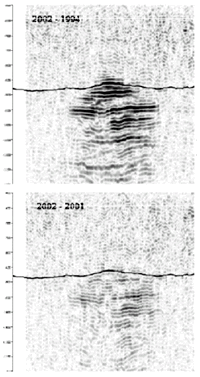
Carbon Sequestration
Monitoring, Mitigation & Verification
|
|
| |
|
| |
 |
| |
3D Seismic conducted at the Sliepner Field show a bright CO2 signature and no leakage above the Utsira formation. |
The area of monitoring, mitigation, and verification (MM&V) is aimed at providing an accurate accounting of stored CO2 and a high level of confidence that the CO2 will remain sequestered permanently. MM&V research seeks to obtain:
- Instruments that can detect carbon in a storage reservoir and/or measure its movement and its physical and chemical state with useful precision;
- The capability to interpret and analyze the results from such instruments;
- The ability to use modeling to predict how movement and/or chemical reactions of carbon in the reservoir will affect (1) the permanence of storage, (2) the environmental impacts within the reservoir, and (3) any impacts on human health; and
- Best practices and procedures that can be used to respond to any detected changes in the condition of the stored carbon and thus mitigate losses of carbon and/or negative impacts on the environment and human health.
A successful effort will enable sequestration project developers to ensure human health and safety, and prevent damage to the host ecosystem. The goal is to provide sufficient information and safeguards to enable developers to obtain permits for sequestration projects. MM&V also seeks to support a system of emissions reduction credits that approach 100% of injected CO2, contributing to the economic viability of sequestration projects. Finally, MM&V will provide improved information and feedback to sequestration practitioners, thus accelerating technology progress.
MM&V efforts are divided into two sub-areas:
Geologic formations. MM&V systems that focus on below-ground CO2 draw upon a significant capability developed for fossil fuel exploration and production. Work is focused on: (1) refining existing CO2 detection technologies and developing new ones, and (2) developing models of subsurface systems that enable processing and analysis of information from detection devices. Measurement technologies being investigated include surface-to-borehole seismic, micro-seismic, cross-well electromagnetic, and electrical resistance tomography. This area is less mature and is focused on detecting leaks or deterioration in reservoirs, and assessing ecological impacts of geologic carbon storage.
Terrestrial ecosystems. Traditional methods for measuring carbon in terrestrial ecosystems (e.g., measuring tree diameters, and analyzing soil samples in an off-site laboratory) are labor-intensive and costly. The program is developing automated technologies that offer lower-cost and more detailed, timely information that can be used to proactively manage sequestration sites.
A number of the technological elements associated with carbon capture and storage are proven, but several modeling scenarios and mitigation techniques are required for a complete understanding of the long-term performance issues at large industrial sites that integrate carbon capture, transportation, and final storage. Much of the knowledge base pertaining to carbon capture and storage has been derived from the oil and natural gas industries, where CO2 has been injected for over 30 years for enhanced oil recovery. Broader research is required and needed research areas identified and being pursued by NETL include the following:
Modeling
- Modeling that focuses on the geologic response to CO2 sequestration in the intermediate zone between the point of injection and the surface area.
Mitigation Techniques
- Deep monitoring techniques capable of compiling data during and after injection.
- Technology capable of total or near-total elimination of leaks around wells and fault and fracture pathways networks.
- Development of logging, seismic, geochemical, hydrodynamic, and test simulations to help understand the conductive properties of caprock prior to and after injection.
Protocols for sequestration projects, both geologic and terrestrial, are currently under development by many different organizations. With respect to permitting, DOE officials work closely with their counterparts at the U.S. Environmental Protection Agency (EPA) to ensure that CO2 injection and monitoring wells comply with state and Federal regulations, most notably the Safe Drinking Water Act. Representatives from DOE and the Carbon Sequestration Regional Partnerships were involved in providing comments for EPA’s Underground Injection Control program, giving regulatory agencies enhanced flexibility in expediting experimental technology well projects.
The scope of coordination extends beyond Federal agencies. A successful sequestration project involves Federal and state agencies, insurance companies, the CO2 producer, the sequestration site operator, and the landowner. All of these entities are responsible for helping to determine the chain of custody, develop appropriate bonding mechanisms, remediate any problems, and provide long-term monitoring. Stakeholders also work together on outreach and education issues to ensure that the general public is aware of carbon capture and sequestration and the large role they might play in the reduction of greenhouse gas emissions.
|